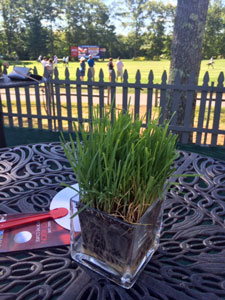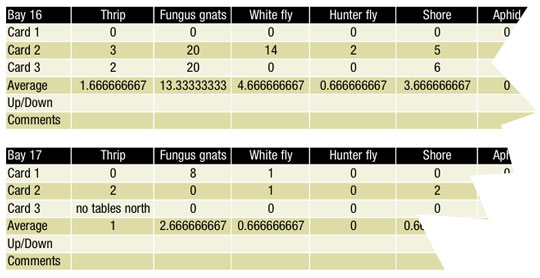10/28/2015
BCAs–A Year in Review
Roger McGaughey

How did our biological control work this year? Overall, rather well. Did we learn a lot of new things or things to do again or not to be repeated? Yes! Have we still got a lot to learn? Of course, but we have built a stronger foundation for going forward. Hopefully, our customers are reaping the benefits. We’ve had a lot of positive feedback from them and even site visits from a few to check in and see how we’re running our biological program.
Last weekend, my wife and I attended a party at Pioneer Gardens hosted by Arjen and Jaap to celebrate their 20 years in business. We saw lots of old photos and heard stories of how they started out farming in the Deerfield Valley. While at the event, I was introduced to one of their valley friends and she said, “Oh, you must be the IPM dude.” I’ve been called “Mr. Nematode” in my day also, but that’s fine because, as these articles are meant to convey, it proves that the BCA message is getting out there. We’ve come a long way in the last year and more nursery employees are getting involved, which is great. Following a BCA seminar, Amanda, our assistant grower, has really come up trumps with a scouting innovation, but she’ll talk about that later.
Figure 1: At the Deutsche Bank Golf Tournament, grass in decorative glass containers were on the lunch tables—complete with fungus gnats.
I recently attended the Deutsche Bank Golf Tournament. While having lunch in one of the hospitality tents, I paid attention to the table decorations. Cereal banker plants? Well, almost! I thought, “Great—even the PGA tour is getting in on the action.” There were little square glass containers with grass in them, but, alas, no aphids or aphid mummies (see Figure 1). On closer inspection I did, however, see some fungus gnats crawling among the shoots. It brought back the reality that the starting point is in the greenhouse and if we do not control the resident fungus gnat population, they’ll come back to seriously bite us. Our prop control program is going well, with very low pest levels, as can be seen in Amanda’s scouting section below. A mixture of Citation (for fungus gnat control), Pageant (as a rooting aid) and Uptake (for disease control) has recently been very effective.
A twice-weekly application of nematodes helps with fungus gnat control and really does a number on thrips. We don’t have banker plants in prop, but do have some in secondary prop, as in the rest of the growing areas. As in all things, timing is really important and this is especially true with nematode applications. There was, in midsummer, a thrips population explosion, but this was mainly in an open roof house where the insects dropped in from on high. There was no foliar damage, but the yellow cards were suddenly covered. I felt confident that we were ahead of the game and there was no real need to panic.
As we were at the start of a really hot spell, it jogged my memory that we needed to readjust our application practices. With ambient temperatures being higher, leaf temperatures are consequently higher and the nematode solution will evaporate off the foliage more rapidly. So we used booms where we had them or applied a fine spray by hand to put a quick pass of water on the crops immediately prior to application. Keeping the foliage moist for at least two to three hours to allow the nematodes to work is a real priority. This was one of the conditions set for Linda, our very conscientious lead watering person, before she started the process this season. As temperatures rose, she was very quick to come back to me saying that we weren’t doing it right—the foliage was drying out too fast. The benefit of double-checking. Thus, the change of procedure from just simply spraying the nematode mixture. This is another year when we don’t have a thrips problem.
Our outside field banker plants have also been a success. Continual checking has shown a good Orius population. They’ve been found in daylily flowers about 50 ft. away from the rows of host plants and recently our Biobest rep, Doug, was impressed with what he was seeing. We found Orius in the Purple Flash Peppers, lots in the lobularia and more deep in marigold and leucanthemum flowers. Inspecting deep down in the mullein plants, I found a lot of adult
Dicyphus and even a few green nymphs. This proves that the reproduction process is working and gives me confidence to repeat the exercise again next year. Dicyphus is a generalist predator and along with the
Orius, the daylily foliage has stayed very free of thrips damage this season. Not having to spray lots of nasty pesticides is obviously huge.
Our banker-plant rearing students are continuing to experiment with ways to produce a better cereal plant during the off season so that next year’s crop will hold up better following the transition from classroom to the greenhouse environment. Our cereal pots this year have not looked very pretty, but have certainly been effective. Aphid mummies have been found on many crops and
Aphidius are still showing up on yellow cards, as seen in the scouting reports. How do we record all our scouting information? Well, that’s where Amanda’s ingenuity comes into play, so here in her own words is her contribution:
“This past June, several of us from Pioneer Gardens attended a Biological Control Conference at UCONN. Whether you are a young grower like me with only a few years of experience under your belt or an experienced grower like Roger, it is important to attend educational seminars and find ways to use the information to implement changes that will benefit your operation. From this conference at UCONN, I learned about two things that I knew I wanted to start using in the greenhouse: an iPad for scouting and a blower to spread the biological controls that we get in every week.
“One thing that Roger and I have in common is that you will find both of us almost always have our iPhone on us, so when I saw that people were using iPads to track scouting, I got very excited. Our old process involved hand writing all of our records on paper in the greenhouse (which can get very messy) and then passing that on to someone in the office to type up and record in Excel. I proposed that we get two iPads and use Google Drive Sheets to record what we find on our yellow cards. An iPad mini and a rugged case for it will only set you back a few hundred dollars. With the labor we are saving by cutting out the middle person, it pays off quickly. In addition to saving labor, Roger is able to access the reports as soon as we have recorded the data. Using Google Drive means we are able to pull up the report any time on a computer or a mobile device. Because the information is so easy to pull up and monitor week to week, we can see if we are getting on top of any problems and we can also use the information to forecast BCA orders. (See Figure 2 for a sample weekly scouting report.)

“Besides being a young grower, I am a short grower, so once again I got excited when I heard about using a blower to spread biologicals rather than climbing in between our ebb/flood tables which is difficult and time consuming. Our Biobest representative, Doug, sent us a blower to use and suggested trialing a mix of
Amblyseius swirskii and nutrimite. To a 25,000-quantity tube of
swirskii, we add a teaspoon of nutrimite, which the
swirskii can feed on until they are applied. The nutrimite is stored in the freezer, then brought up to room temperature before mixing with the
swirskii. The combination is then spread out over 2,500 sq. ft. of tables. Recently, I was able to spread 100,000
swirskii in only 20 minutes—a task that without the blower would have taken me over an hour to complete. We are saving a lot of time by using the new blower and scouting reports show that we have gotten control of a recent whitefly outbreak.”
Technology continues to improve at a fast pace and enables us to do lots from afar, but there’s no substitute for getting into your crops and making sure that they will provide our customers with the quality that they expect and deserve.
GT
Roger McGaughey, head grower at Pioneer Gardens in Deerfield, Massachusetts, was educated in Northern Ireland and England and has 40 years experience as a grower.